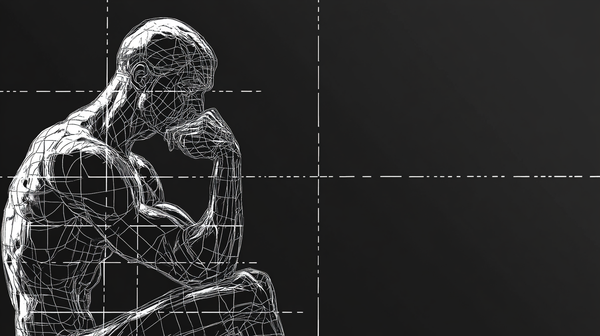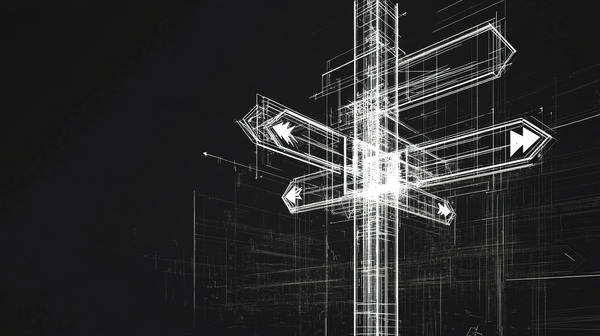When AI Can Do Your Job: The Tech Leader's Path from Crisis to Purpose
As AI assumes operational functions, the value of human leadership emerges from navigating boundaries. Purpose develops through constructing coherence across fundamentally different domains, recognizing vitality patterns, and maintaining structural viability under changing conditions.

(This is the first in an irregular series called "When AI Can Do Your Job." This essay examines technical leadership.)
The email arrives at 3:47 AM. Not from a colleague working late, but from an AI system that has just completed a comprehensive competitive analysis, identified three strategic opportunities, drafted implementation plans, and allocated resources across departments. The work is impeccable. It's better than what your team produced last quarter, completed in minutes rather than weeks.
You're the CTO who championed this AI implementation. You've spent your career climbing the technology leadership ladder, building expertise in strategic planning, technical architecture, and organizational transformation. Now, watching the AI execute these functions with superior speed and accuracy, a question crystallizes: If AI can do my job better than I can, what is my purpose?
This isn't hypothetical anxiety. It's the reality confronting technology leaders who find themselves on both sides of the automation equation and implementing systems that may render their own roles obsolete.
The Paradox of the Automator
Technology leaders face a unique existential challenge. Unlike workers in other industries who experience AI disruption as an external force, CTOs and tech executives are actively building the systems that challenge their own relevance. This creates the "Automator's Paradox": the more successful you are at implementing AI, the more you undermine the traditional basis of your own value.
Consider what defines a tech leader's traditional worth: strategic analysis and planning, technical decision-making, resource optimization, pattern recognition within established frameworks, and risk assessment within defined parameters. Each of these capabilities involves pattern matching and optimization within specified constraints, tasks where modern AI systems excel.
The Illusion of Indispensability
Faced with AI's growing capabilities, tech leaders typically respond with one of two defensive strategies, both of which ultimately fail to address the fundamental question of purpose:
1. Complexity Theater
Many leaders double down on creating increasingly elaborate processes, metrics, and organizational structures that seem to require human oversight. This is a form of what Autogenic Realism identifies as feedback distortion: when systems generate activity that appears purposeful but actually serves to maintain existing structures rather than enhance viability. Leaders manufacture complexity to justify their roles, creating bureaucratic mazes that require navigation rather than solving real problems.
2. Soft Skills Defensiveness
Others hastily reposition leadership as primarily about emotional intelligence, empathy, and culture-building. While these capabilities are genuinely valuable—forming the connective tissue of human organizations—the problem lies in their defensive deployment. When leaders position soft skills as the last refuge of human value ("AI can't do this!"), they avoid engaging with deeper questions about purpose.
Both strategies share a common flaw: they attempt to preserve relevance by redefining the role rather than confronting the fundamental question of what makes human leadership valuable in an age of artificial intelligence. Neither addresses the structural reality that human purpose may lie beyond functional performance altogether.
Beyond Defense: Understanding Human Value in Complex Systems
To move beyond defensive strategies, we need to understand what makes human leadership structurally valuable in complex systems. The answer lies in how consciousness processes experience to generate meaning through integrated engagement with reality. This is a capacity that emerges from the interplay of three fundamental dynamics:
Vitality is the directional pattern of adaptive development in living systems. Unlike mere efficiency, vitality manifests as a system's capacity to maintain coherence while creatively adapting to novel constraints. Recognizing vitality, that is, distinguishing genuine flourishing from mere functioning, requires experiential understanding that emerges from how consciousness integrates multiple dimensions of feedback across time. For instance, a team displaying vitality might temporarily decrease productivity metrics while exploring new approaches, or an organization might maintain redundant communication channels that appear inefficient but create resilience during crises.
Value boundaries are the zones where different systems or domains with distinct operating logics meet and create tension. Recognizing vitality depends on navigating these value boundaries. They exist where formal systems encounter informal realities, where multiple stakeholder needs create irreducible conflicts, or where technical capabilities meet ethical boundaries. Unlike artificial complexity, genuine value boundaries require constructing coherence across fundamentally different domains of value and operation.
Structural viability is a system's ability to preserve functional coherence while adapting to changing conditions. The capacity to navigate value boundaries while maintaining structural viability is what distinguishes human judgment. This involves more than efficient task execution; it requires evaluating trade-offs between competing goods and integrating feedback across multiple dimensions and temporal scales. For example, deciding whether to prioritize short-term profitability or long-term research investment, or determining how to balance employee wellbeing with market competitiveness during rapid scaling.
These three dynamics converge in human consciousness through recursive self-modeling and experiential integration. While AI excels at pattern recognition within defined parameters, consciousness processes experience in ways that generate meaning—not through superior computation, but through the structural capacity to construct coherent understanding across incommensurable domains. This is the foundation of human value in complex systems: our ability to recognize vitality patterns, navigate value boundaries, and maintain structural viability through integrated engagement with reality.
The Structural Reality of Purpose
Purpose, in Autogenic Realism, is a structural phenomenon that emerges when conscious systems engage with reality's constraints in ways that generate coherent patterns of meaning and development. Purpose emerges from the intersection of three structural conditions:
- Constraint Engagement: When a system encounters limitations that require creative navigation rather than simple execution
- Coherence Construction: When navigation across multiple domains generates integrated understanding rather than fragmented solutions
- Developmental Orientation: When this process contributes to enhanced vitality across temporal scales
This structural view reveals why simply performing tasks well, even complex ones, cannot generate purpose. When a problem can be fully defined and solved through optimization, it lacks the fundamental tensions that require us to construct meaning. Purpose emerges specifically when we face competing demands that can't be reconciled through calculation alone. These are situations where we must creatively bridge different value systems or navigate between conflicting but equally valid needs.
Consider why solving a complex optimization problem feels different from navigating an ethical dilemma. The optimization problem, however difficult, operates within defined parameters with clear success criteria. The ethical dilemma requires constructing coherence between competing value systems. This process generates meaning through the very act of navigation.
This explains why automation paradoxically clarifies rather than diminishes human purpose. As AI assumes more defined functions, it strips away the illusion that purpose resided in those functions. What remains is the structural reality: purpose emerges from conscious engagement with constraints that require constructing new forms of coherence.
Purpose in Technology Leadership
When we examine tech leadership through this structural lens, a shift occurs. Traditional leadership value in strategic planning, resource optimization, and risk assessment consists largely of functions within defined parameters. These can be automated precisely because they don't require the constraint navigation that generates purpose.
A tech leader's structural purpose emerges instead from:
1. Navigating Value Boundaries
Current AI systems demonstrate superior performance in tasks with well-defined parameters and success criteria, while human leaders show distinctive capabilities when navigating the boundaries between systems with different operational logics and value structures. This boundary navigation involves recognizing how patterns in one domain affect patterns in fundamentally different domains—a capability that emerges from how human consciousness processes experience through recursive self-modeling and experiential integration. While AI systems continue to evolve, their current structural approach to information processing differs significantly from the way human consciousness constructs coherence across incommensurable domains.
For instance, when an AI system recommends eliminating customer success teams based on automated support metrics showing high query resolution rates, human leadership recognizes a critical value boundary: high-value enterprise clients rely on relationship managers not for query resolution but for strategic guidance and trust-building. The AI optimizes for efficiency within defined parameters (support metrics); humans navigate the boundary between technical support and business relationships, recognizing that different stakeholders operate with fundamentally different success criteria.
2. Constructing Coherence Across Domains
Current AI systems demonstrate superior capability in optimization tasks within defined parameters but show significant limitations when attempting to construct coherence across domains operating with fundamentally different value systems or operational logics. These systems lack the experiential integration that allows human consciousness to recognize how patterns in one domain affect and are affected by patterns in entirely different domains. While AI may eventually develop more sophisticated capabilities for cross-domain integration, the structural differences in how AI and human consciousness process information suggest that their approaches to coherence construction will remain fundamentally distinct.
Consider implementing advanced AI systems like GPT-4 in financial services. While AI might propose using language models for automated financial advice based on performance metrics, human leadership must construct coherence between technical capabilities (what the AI can do), regulatory constraints (what the law permits), ethical considerations (what serves client wellbeing), and business model implications (what sustains the organization). The resulting framework creates a coherent system that balances innovation with responsibility—not through optimization within parameters but through negotiating the parameters themselves.
3. Recognizing and Cultivating Vitality
Perhaps most critically, humans possess the structural capacity to recognize and foster vitality—distinguishing systems that are merely functional from those that exhibit genuine adaptive development. This capacity emerges from how consciousness processes information: through recursive self-modeling, integration of multiple feedback streams, and construction of meaning across temporal scales.
When an AI suggests restructuring teams based purely on performance metrics, human leadership recognizes vitality patterns that emerge from: cross-functional friction that generates novel solutions, periods of apparent stagnation that precede breakthrough insights, and seemingly redundant communication pathways that create system resilience. This isn't intuition or emotional intelligence it's pattern recognition operating across multiple dimensions of systemic behavior, enabled by consciousness's capacity to process experience rather than just data.
The Crisis-to-Purpose Bridge: Identifying Your Value Boundaries
Before implementing new approaches, leaders must identify where they create unique value through navigating boundaries between different systems. Key diagnostic questions include:
- Where do formal organizational processes meet informal human realities in ways that create irreducible tension? Example: Your performance review system rates employees on quantifiable metrics, but your best innovators often score poorly because their exploratory work doesn't fit standard measurement criteria. The tension between measuring performance and fostering innovation can't be resolved by better metrics alone.
- What stakeholder conflicts persist despite optimization attempts, suggesting fundamental value differences rather than process inefficiencies? Example: Product teams want to ship features quickly to stay competitive, while security teams demand extensive testing that slows releases. No amount of process optimization eliminates this tension because it reflects different core priorities: speed versus safety.
- Where do technical solutions consistently fail to address organizational challenges, indicating missing contextual integration? Example: You've implemented multiple project management tools, but teams still struggle with alignment. The issue isn't the technology—it's that different departments have fundamentally different concepts of what "project success" means.
- What decisions require you to hold multiple, competing goods in tension rather than optimizing for a single metric? Example: Deciding whether to maintain legacy systems that key clients depend on versus investing those resources in next-generation platforms. Both choices serve important values—customer stability and innovation—that can't be reduced to a simple ROI calculation.
- Where does your organization's vitality (adaptive capacity, creative output, resilient culture) diverge from its efficiency metrics? Example: Your most efficient teams hit all their KPIs but rarely produce breakthrough innovations, while your "messier" teams miss deadlines but generate the ideas that define your company's future. The divergence suggests vitality patterns that efficiency metrics don't capture.
These questions help distinguish genuine value boundaries from artificial complexity, focusing leadership attention where human judgment creates systemic value.
From Crisis to Renewal: Reconstructing Purpose
The recognition that meaning emerges from navigating value boundaries rather than performing functions opens a path from existential crisis to renewed purpose. But what does this look like in practice, and why does it matter?
When tech leaders successfully reorient toward value boundaries and away from functional performance, three transformative shifts occur:
First, work becomes more energizing rather than depleting. Instead of competing with AI on metrics it will inevitably win, you engage in the creative challenge of navigating between different domains of value—a process that generates meaning through the very act of navigation. The sense of purpose emerges not from executing predefined tasks, but from constructing coherence where none previously existed.
Second, your leadership becomes more necessary, not less. As AI handles optimization within domains, the need for navigation between domains increases. Organizations require leaders who can identify where different value systems meet, recognize the patterns of vitality that metrics miss, and construct bridges between technical capabilities and human needs. Your value doesn't diminish—it clarifies.
Third, your strategic vision expands beyond incremental improvement to meaningful innovation. When you focus on value boundaries, you recognize possibilities that optimization alone cannot discover—the breakthrough products that connect previously separate domains, the organizational structures that balance competing goods without sacrificing either, the strategic directions that enhance multiple forms of value simultaneously.
This isn't just career preservation—it's an evolution toward what creates genuine value in complex human systems. Here's how tech leaders can systematically reconstruct their purpose through three phases, followed by key capabilities that enable sustained viability:
Phase 1: Diagnostic Reframing
Diagnostic reframing begins with shifting foundational questions. Instead of asking "What functions justify my role?" tech leaders must examine "What patterns of coherence am I uniquely positioned to construct?" This reorientation moves beyond defending territory to identifying where human judgment creates systemic value.
The process involves systematic mapping of decision contexts across the organization. Tech leaders must track where their interventions create connective tissue between different value systems or operational frameworks. This isn't abstract reflection but concrete analysis of where organizational tensions emerge that can't be resolved through simple optimization.
Effective diagnostic reframing requires establishing where the most significant boundaries exist. Which systems within the organization operate with fundamentally different success criteria? Where do departmental priorities create irreducible tensions? What stakeholder needs demonstrate incompatible timelines or risk tolerances? Leaders must document these constraint interfaces to identify where their value consistently manifests.
Perhaps most critically, this phase involves recognizing what patterns they intuitively perceive that formal systems consistently miss. When do teams exhibit vitality despite poor metrics, or display concerning fragility despite excellent performance numbers? These discrepancies signal the boundary zones where human perception operates beyond algorithmic assessment.
Sarah Chen's Experience: As CTO of a mid-sized fintech company, Sarah initially panicked when her AI implementation began outperforming her strategic planning team. Her first diagnostic step involved creating a decision journal that documented every significant judgment call she made over a six-week period. For each decision, she noted whether it primarily involved optimization within a single domain or navigation between conflicting domains. Reviewing this journal, she identified three recurring boundary zones where her judgment consistently added value: mediating between immediate engineering priorities and long-term architectural integrity; reconciling regulatory compliance requirements with innovation goals; and balancing data-driven decision making with ethical considerations around customer autonomy and privacy.
Sarah then conducted structured interviews with her leadership team, asking them to identify situations where AI recommendations would miss critical contextual factors. These conversations revealed that while AI excelled at optimizing resource allocation within existing frameworks, it consistently failed to recognize when team exhaustion was building beneath productivity metrics or when seemingly inefficient cross-functional collaboration was germinating breakthrough innovations. She created a map of these vitality indicators and began systematically tracking where her judgment recognized patterns that metrics missed.
Phase 2: Structural Repositioning
Structural repositioning requires leaders to fundamentally reorganize their work around viability enhancement rather than functional execution. This is a systemic reorientation of how leaders engage with organizational challenges and constraints, not just a cosmetic shift in job description.
The first component involves creating structural separation between optimization functions and coherence-building functions. Leaders must intentionally delegate optimization tasks—even complex ones—to AI systems and human specialists focused on specific domains. This delegation isn't mere efficiency; it creates space for focusing on the boundary zones identified during diagnostic reframing.
The second component involves developing feedback systems that detect vitality indicators, not just performance metrics. These systems track adaptive capacity, innovation frequency, team resilience, and cross-functional collaboration effectiveness. Unlike traditional metrics focusing on what is easily measurable, vitality indicators require multiple information streams integrated through experienced judgment.
The third component involves establishing decision frameworks that explicitly navigate between competing values rather than optimizing for single metrics. These frameworks don't avoid tensions—they structure engagement with them, treating the navigation process itself as central to leadership rather than as a preparation for a "correct" answer.
Finally, structural repositioning requires creating collaborative spaces specifically designed for constraint navigation. These aren't traditional problem-solving sessions but structured environments where teams collectively engage with boundary zones, developing shared capacity to construct coherence across domains.
Sarah's Implementation: Sarah restructured her leadership practice by first creating clear delineation between optimization functions and boundary navigation. She identified which strategic planning and resource allocation tasks could be handled by AI systems and specialized teams, freeing 40% of her time for focusing specifically on value boundary navigation.
She worked with her leadership team to develop an expanded assessment framework that supplemented traditional performance metrics with vitality indicators. These included team adaptation rate (how quickly teams could reorganize around new challenges), innovation emergence patterns (where and when breakthrough ideas appeared relative to formal innovation processes), and cross-boundary collaboration quality (the effectiveness of communication across departments with different operational logics).
Sarah established a new meeting structure called "Boundary Sessions" where representatives from different domains (engineering, compliance, customer success, product) collaborated specifically on challenges that crossed their value systems. Unlike traditional cross-functional meetings focused on alignment and compromise, these sessions explicitly engaged with tensions between different success criteria, treating navigation itself as their primary function.
She reorganized her calendar to spend 30% of her time in direct observation of team functioning, not just reviewing metrics. This observation focused on detecting patterns of vitality that formal reporting consistently missed: signs of emerging burnout despite productivity metrics, indications of creative stagnation despite meeting innovation metrics, or unusual cross-functional collaborations generating unexpected value.
Most significantly, Sarah created a formal role called "Integration Architect" within her leadership team. While traditional architects focused on technical systems, these architects specifically worked at organizational boundary zones, helping construct coherence between departments operating with different value systems and creating bridges between technical capabilities and human contexts. Sarah positioned her own leadership as the meta-architect of these integration functions.
Phase 3: Meaning Construction
Meaning construction is the most significant phase of purpose reconstruction. It transforms the structural work of phases one and two into sustainable practices that generate ongoing coherence and development. This isn't about finding meaning despite work; it's about actively constructing meaning through engagement with genuine constraints.
The process begins with identifying real challenges that require human creativity and judgment—not manufacturing complexity, but recognizing where organizational tensions genuinely demand constructive navigation. Leaders must distinguish between problems to be solved (optimization within domains) and polarities to be navigated (tensions between equally valid values that can never be finally resolved, only creatively engaged).
The second component involves connecting individual contribution to systemic viability. Leaders must help team members see how their work at boundary zones contributes to organizational flourishing—not as abstract vision statements, but as concrete mapping between daily navigation and system-level enhancement.
The third component involves establishing practices that make constraint navigation explicit and valued. This includes creating specific language for boundary work, developing frameworks that support constructive engagement with tensions, and building assessment systems that recognize coherence construction as core to organizational function.
Finally, meaning construction requires developing environments where others can construct purpose through their own engagement with constraints. Leaders must create conditions where teams experience the generative tension of navigating between different values, recognizing how this process itself—not just its outcomes—creates meaning and development.
Sarah's Results: Sarah transformed her leadership approach from executing functions to constructing meaning through constraint engagement. She developed a formal framework called "Boundary Navigation" that explicitly addressed the interfaces between different organizational value systems. This framework included specific language for discussing tensions between speed and quality, innovation and stability, autonomy and coordination—treating these not as problems to be eliminated but as generative constraints to be navigated.
She created a development program called "Integration Leadership" that trained managers specifically in boundary work. This program taught concrete skills for recognizing value boundaries, facilitating navigation between different operational logics, and constructing coherence across domains. Graduates became integration specialists who helped teams engage constructively with organizational tensions rather than trying to eliminate them.
Sarah established quarterly "Vitality Assessments" that examined patterns of organizational flourishing beyond traditional performance metrics. These assessments tracked how effectively teams navigated constraints, adapted to changing conditions, and constructed coherence across boundaries. The assessments provided concrete feedback on boundary navigation as a valued leadership function, not just an incidental challenge.
Most significantly, Sarah transformed her own leadership narrative from "chief optimizer" to "coherence architect." She explicitly communicated how her role created value not by outperforming AI in optimization tasks, but by constructing coherence across domains where no predefined parameters existed. This wasn't defensive repositioning—it was authentic recognition that her contribution emerged precisely from navigation between systems rather than execution within them.
The results were transformative. Teams reported higher engagement when working on boundary challenges that required creative navigation rather than mere execution. Innovation increased specifically at the interfaces between different domains, where competing constraints generated creative tension. The organization developed enhanced viability—not just performing well on existing metrics, but demonstrating increased capability to adapt to changing conditions, recognize new opportunities, and maintain coherence through complex challenges.
Living Your Reconstructed Purpose: The New Leadership Practice
After completing the three-phase reconstruction process, tech leaders emerge with a fundamentally different leadership practice. This isn't merely an adjusted mindset or refined skillset—it's a transformed way of engaging with organizational reality that creates value precisely where AI cannot. The reconstructed leadership practice manifests in how you navigate complexity day-to-day, creating coherence across domains where no single framework fully captures the situation.
What does this reconstructed leadership actually look like in practice? Let's examine how it manifests in daily engagement:
Experiential Integration in Decision-Making: While AI excels at analyzing metrics and predicting based on historical patterns, your reconstructed leadership draws on experiential understanding that operates differently from computational analysis. When evaluating team dynamics, you don't just process data points—you recognize the specific quality of engagement that precedes innovation or the subtle signals of approaching burnout.
Sarah experienced this distinction when reviewing a major project post-implementation. The AI analysis showed excellent efficiency metrics, but Sarah recognized patterns she had experienced before: the subtle disengagement that precedes talent departure, the specific quality of technical solutions that indicates future maintenance challenges, and the relational dynamics that would affect knowledge transfer. This wasn't superior analysis. It was a structurally different kind of knowing that emerged from her lived experience navigating similar situations. She initiated conversations that addressed these patterns before they affected performance metrics, explaining to her team: "The data looks excellent, but I'm sensing patterns we've seen before that suggest we need to address underlying dynamics now."
Paradox Navigation as Core Function: Rather than treating tensions as problems to be solved or balanced, your leadership practice engages them as generative forces. You don't simply make trade-offs between competing values—you construct frameworks that honor multiple values simultaneously.
For Sarah, this manifested when implementing a new AI-based development platform. Rather than optimizing for either speed or quality, control or autonomy, she created structures that transformed these tensions from either/or choices to both/and possibilities. She established autonomous teams with clear integration touchpoints, implemented rapid iteration cycles with embedded quality metrics, and developed feedback systems that honored both immediate performance and long-term capacity building. When teams encountered conflicts between these values, she didn't direct them toward compromise; she helped them construct approaches that used the tension itself as a creative force.
Coherence Construction Across Value Systems: Your most distinctive contribution emerges at the interfaces between different operational logics—where engineering meets design, where technical capability meets regulatory constraints, where efficiency meets human experience. Here, your capacity to construct coherence across fundamentally different value systems creates organizational integrity that optimization alone cannot achieve.
During a major AI transformation initiative, Sarah recognized that different departments operated with incompatible success criteria. Engineering measured success through technical functionality, customer success through relationship quality, finance through cost efficiency, and executive leadership through competitive positioning. Rather than forcing alignment to a single metric framework, she created what she called "translation interfaces"—structured conversations and artifacts that maintained each department's core values while establishing just enough shared understanding to enable coordinated action. These weren't compromise solutions but newly constructed frameworks that honored multiple value systems simultaneously.
Vitality Recognition and Cultivation: While AI excels at measuring defined performance indicators, your leadership practice focuses on recognizing and fostering vitality—the patterns of adaptive development that often exist beneath or beyond formal metrics. You identify where genuine flourishing diverges from productivity data, where apparent efficiency masks developmental stagnation, or where short-term disruption signals breakthrough innovation.
Sarah implemented this practice by establishing periodic "Vitality Reviews" that deliberately looked beyond performance metrics to assess adaptive capacity. These reviews examined specific patterns: How did teams respond to unexpected challenges? Where did cross-functional collaboration generate novel solutions? When did apparent inefficiency actually reflect valuable exploration? She trained managers to recognize these patterns not as deviations from optimization but as signals of developmental health. This wasn't subjective evaluation but structured assessment of vitality indicators that optimization frameworks consistently miss.
Meaning Architecture Through Constraint: Perhaps most fundamentally, your reconstructed leadership creates value by transforming constraints from limitations to be overcome into boundaries that generate meaning. You recognize that purpose emerges not from unlimited possibility but from creative engagement with the specific conditions and limitations of your organizational reality.
Sarah embodied this practice when her team faced severe resource constraints during a critical implementation phase. Rather than treating these constraints as obstacles to innovation, she reframed them as the specific conditions that would generate creative focus. "These aren't limitations keeping us from doing what matters," she explained to her team. "They're the boundaries that make our work meaningful by forcing us to identify what's truly essential." This wasn't positive thinking but practical recognition that meaning emerges from navigating real constraints rather than from unlimited optionality.
These practices aren't parallel to traditional leadership functions—they represent a transformed understanding of what leadership fundamentally is in an AI-dominant environment. Your value no longer derives primarily from knowing more, deciding better, or executing faster than others. It emerges from your capacity to construct coherence precisely where optimization frameworks break down: at the boundaries between systems, at the interfaces between value domains, and at the edges of established understanding.
This isn't leadership as an advanced skill set but leadership as meaning construction—creating frameworks that enable human systems to navigate complexity, contradiction, and constraint in ways that generate sustained vitality rather than short-term optimization. The practices you've developed through the three-phase reconstruction process now manifest as your daily engagement with organizational reality, creating value that emerges not from outperforming AI but from operating in a fundamentally different domain: the construction of meaning across boundaries where no predefined parameters exist.
The Tech Leader's New Mandate: Industry Context and Evolution
The tech leadership landscape of 2025 presents a profound transformation of roles and market dynamics. According to research from McKinsey, AI implementation faces a significant barrier not in technology or employee readiness, but in leadership itself—executives are more than twice as likely to blame employee readiness for slow adoption than to acknowledge their own role as the primary constraint[1]. This disconnect highlights the critical need for tech leaders to reimagine their function beyond traditional performance metrics.
The job market reflects this shifting reality. While the World Economic Forum predicts that by 2025, AI and automation may displace approximately 85 million jobs, they also project the emergence of 97 million new roles adapted to the division of labor between humans, machines, and algorithms[2]. For tech leaders specifically, new positions are emerging that emphasize strategic oversight rather than operational execution. Roles such as Heads of AI, AI Architects, and Decision Engineers are gaining prominence as organizations seek leaders who can translate AI capabilities into business value[3].
Global tech spending is projected to reach $5.26 trillion in 2024, with continued growth into 2025 according to Gartner[4]. This investment surge isn't merely directed at software implementation but represents a significant shift in enterprise priorities—from optimization within existing parameters to fundamental transformation of operational models. Organizations are recognizing that hardware infrastructure, talent development, and strategic leadership represent critical components of successful AI implementation, far beyond the algorithms themselves.
For CTOs and technology executives, this evolving context demands reimagining leadership across five key dimensions: engineering, talent, financial operations, infrastructure, and risk management[5]. Each dimension requires not merely functional expertise but the capacity to navigate value boundaries between previously separate domains. The CTO role now extends beyond selecting technology stacks to creating strategic frameworks that balance innovation with responsibility.
Within this rapidly shifting landscape, your role as a tech leader transforms from chief operator to chief navigator of constraint interfaces. This isn't a demotion—it's an evolution toward what humans uniquely contribute: the capacity to construct coherent systems that enhance vitality across multiple dimensions. Recent research indicates that 87% of leaders planning to hire in 2025 list AI experience as valuable, but the definition of "AI experience" is expanding beyond technical implementation to include strategic integration and ethical governance[6].
Your purpose isn't threatened by AI's functional superiority; it's liberated from the illusion that your value was ever truly about those functions. The crisis you face isn't one of obsolescence but of recognition—seeing that meaning emerges not from what you do, but from how you engage with reality's constraints to build systems that flourish. As companies shift investment from hiring to AI technology adoption[7], your capacity to navigate value boundaries becomes not just valuable but essential to organizational viability.
Addressing the Deeper Questions
Isn't this just rebranding leadership to preserve relevance?
The distinction between defensive repositioning and genuine structural insight is crucial. Defensive rhetoric focuses on protecting existing roles; structural understanding reveals capacities that emerge from human consciousness itself—our ability to recognize patterns of vitality, navigate conflicting constraints, and construct coherent systems across incommensurable domains. The difference becomes clear through outcomes: defensive positioning maintains the status quo, while genuine insight enables new forms of organizational viability.
Won't AI eventually develop these capabilities too?
While AI may become increasingly sophisticated at handling complex optimization problems, the capacity to experience meaning, recognize vitality patterns through lived experience, and navigate constraint interfaces appears intrinsically linked to consciousness—specifically to how conscious systems process information through recursive self-modeling and experiential integration. Future AI might simulate these processes but would likely do so through fundamentally different structural mechanisms.
How do we distinguish genuine constraints from artificial complexity?
Genuine constraint interfaces involve tensions between fundamentally different value systems or operational logics that cannot be resolved through optimization alone. They require constructing new frameworks that honor multiple, competing goods. Artificial complexity, by contrast, can be simplified once properly understood—it's complicated but not fundamentally irreconcilable.
Conclusion: Purpose Beyond Performance
The question "What's my purpose when AI can do my job?" contains a false premise. It assumes purpose was ever truly about job performance. Autogenic Realism reveals that meaning emerges from our engagement with constraints, our construction of coherent systems, and our capacity to recognize and foster vitality.
As AI handles more operational functions, tech leaders face a choice: cling to increasingly hollow justifications for traditional roles, or embrace the deeper purpose that emerges from navigating reality's boundaries. The crisis isn't that AI can do your job—it's that you've been defining your purpose too narrowly.
Your next strategic plan might be written by AI. Your next organizational restructure might be optimized by algorithms. But the capacity to recognize when a system has vitality versus mere functionality, to navigate the value boundaries where formal meets informal, to construct coherence from competing demands—these remain uniquely human contributions.
The path forward isn't about competing with AI on its terms. It's about recognizing that human purpose transcends functional performance. In an automated world, meaning doesn't diminish—it clarifies. We're freed to engage with what actually generates human vitality: the creative navigation of constraints in service of systemic flourishing.
That 3:47 AM email from the AI system isn't a threat—it's a liberation from the operational functions that were never your true source of meaning. The real question isn't "What's my purpose when AI can do my job?" It's "How do I construct meaning now that I'm freed from the illusion that my job functions were ever my true purpose?"
That's not a crisis. That's liberation.
[1] McKinsey Global Institute, "The State of AI in 2023: Generative AI's Breakout Year": https://www.mckinsey.com/capabilities/quantumblack/our-insights/the-state-of-ai-in-2023-generative-ais-breakout-year
[2] World Economic Forum, "The Future of Jobs Report 2023": https://www.weforum.org/publications/the-future-of-jobs-report-2023/
[3] MIT Sloan Management Review, "The New Leadership Playbook for the Digital Age": https://sloanreview.mit.edu/projects/the-new-leadership-playbook-for-the-digital-age/
[4] Gartner, "Gartner Forecasts Worldwide IT Spending to Grow 6.8% in 2024" (January 2024): https://www.gartner.com/en/newsroom/press-releases/01-17-2024-gartner-forecasts-worldwide-it-spending-to-grow-six-point-eight-percent-in-2024
[4] While I couldn't find the exact "Harvard Business Review 'The Evolving Role of the CTO in the Age of AI' March 2024" article, I found related content about CTO roles in the AI era from EC1 Partners that might be useful: https://ec1partners.com/blog/role-of-the-chief-technology-officer/
[6] LinkedIn Economic Graph Research - While I couldn't find the exact "Global Talent Trends 2025" report from February, I found their recent talent trends reports that provide insights: https://economicgraph.linkedin.com/workforce-data
[7] Deloitte Insights, "Tech Trends 2025: The Next Five Years of Enterprise Technology": https://www2.deloitte.com/us/en/insights/focus/tech-trends.html





